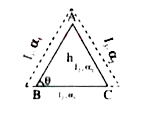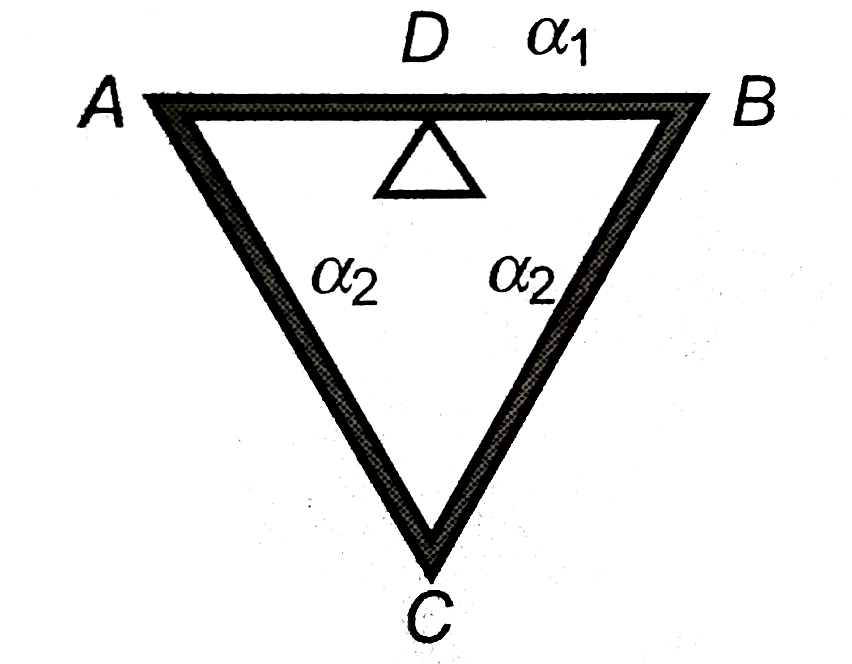Three rods A, B and C form an equilateral triangle at 0°C. Rods AB and BC have same coefficient of expansion and rod AC has . If change in angle between AB and BC is then temperature through which system is heated.

The correct Answer is:B
Topper's Solved these Questions
- THERMAL PROPERTIES OF MATTERBOOK - AAKASH SERIESCHAPTER - THERMAL PROPERTIES OF MATTEREXERCISE - EXPANSION OF SOLIDS (PRACTICE SHEET) LEVEL-II (Straight Objective Type Questions) Mechanics applications
4 Videos
- THERMAL PROPERTIES OF MATTERBOOK - AAKASH SERIESCHAPTER - THERMAL PROPERTIES OF MATTEREXERCISE - EXPANSION OF SOLIDS (PRACTICE SHEET) LEVEL-II (More than One correct answer Type Questions)
5 Videos
- THERMAL PROPERTIES OF MATTERBOOK - AAKASH SERIESCHAPTER - THERMAL PROPERTIES OF MATTEREXERCISE - EXPANSION OF SOLIDS (PRACTICE SHEET) LEVEL-I (Straight Objective Type Questions) Mechanics & Elasticity application
4 Videos
- SYSTEM OF PARTICLES AND ROTATIONAL MOTIONBOOK - AAKASH SERIESCHAPTER - SYSTEM OF PARTICLES AND ROTATIONAL MOTIONEXERCISE - PRACTICE EXERCISE
99 Videos
- THERMODYNAMICSBOOK - AAKASH SERIESCHAPTER - THERMODYNAMICSEXERCISE - EXERCISE - 3
33 Videos
Similar Questions
Three rods A,B and C having indentical shape and size, are hingerd together at ends to form an equilateral triangle. Rods A and B are made of same material having coefficient of linea thermal expansion α1 while that of material of rod C is α2. By how many kelvin should the system of rods be heated to increase the angle opposite to rod C by Δθ.
View SolutionThree rods of equal of length are joined to from an equilateral triangle ABC. D is the midpoint of AB. The coefficient of linear expansion is α1 for AB and α2 for AC and BC . If the distance DC remains constant for small changes in temperature,

View Solution
Knowledge Check
Three rods of equal of length are joined to from an equilateral triangle ABC. D is the midpoint of AB. The coefficient of linear expansion is α1 for AB and α2 for AC and BC . If the distance DC remains constant for small changes in temperature,
 Aα1=α2Bα1=2α2Cα1=4α2Dα1=1/2α2
Aα1=α2Bα1=2α2Cα1=4α2Dα1=1/2α2A metal rof having coefficient of linear expansion α and Young's modulus Y is heated to raise its temperature by Δθ. The stress exerted by the rod is
AYαΔθBYΔθαCYαΔθDαΔθYAn equilateral triangle ABC is formed by joining three rods of equal length and D is the mid-point of AB. The coefficient of linear expansion for AB is α1 and for AC and BC is α2. The relation between α1 and α2, if distance DC remains constant for small changes in temperture is
_E01_117_Q01.png) Aα1=α2Bα1=4α2Cα2=4α1Dα1=12α2
Aα1=α2Bα1=4α2Cα2=4α1Dα1=12α2
Among three rods, the first two are made of same material having coefficient of linear expansion α1 and the third rod is made of material of coefficient of linear expansion α2 . The third rod forms the base of the equilateral triangle when the three rods are arranged to form an equilateral triangle. If the altitude of triangle remains constant at all temperatures, what is the ratio of α1/α2 ?
View SolutionA metal rod having coefficient of linear expansion (α) and Young's modulus (Y) is heated to raise the temperature by Δθ. The stress exerted by the rod
View SolutionTwo rods AB and BC of equal cross-sectional area are joined together and clamped between two fixed supports as shown in the figure. For the rod AB and road BC lengths are l1 and l2 coefficient of linear expansion are α1 and α2, young's modulus are Y1 and Y2, densities are ρ1 and ρ2 respectively. Now the temperature of the compound rod is increased by θ. Assume of that there is no significant change in the lengths of rod due to heating. then the time taken by transverse wave pulse to travel from end A to other end C of the compound rod is directly proportional to
_E01_086_Q01.png)
View SolutionTwo rods of different materials having coefficient of thermal expansions α1 and α2 and Young's moduli Y1 and Y2 respectively are fixed between two rigid walls. The rods are heated, such that they undergo the same increase in temperature. There is no bending of rods. If α1/α2=2/3 and stresses developed in the two rods are equal, then Y1Y2 is:
View SolutionTwo rods of different materials having coefficient of thermal expansions α1 and α2 and Young's moduli Y1 and Y2 respectively are fixed between two rigid walls. The rods are heated, such that they undergo the same increase in temperature. There is no bending of rods. If α1/α2=2/3 and stresses developed in the two rods are equal, then Y1Y2 is:
View Solution
